List of Contents
Power-To-Gas Market Size and Forecast 2025 to 2034
The global power-to-gas market size accounted for USD 35.80 million in 2024 and is projected to hit around USD 96.68 million by 2034, growing at a CAGR of 10.44% during the forecast period from 2025 to 2034. The growth of the power-to-gas market is driven by the increasing demand for electricity worldwide and the rising use of renewable energy sources.
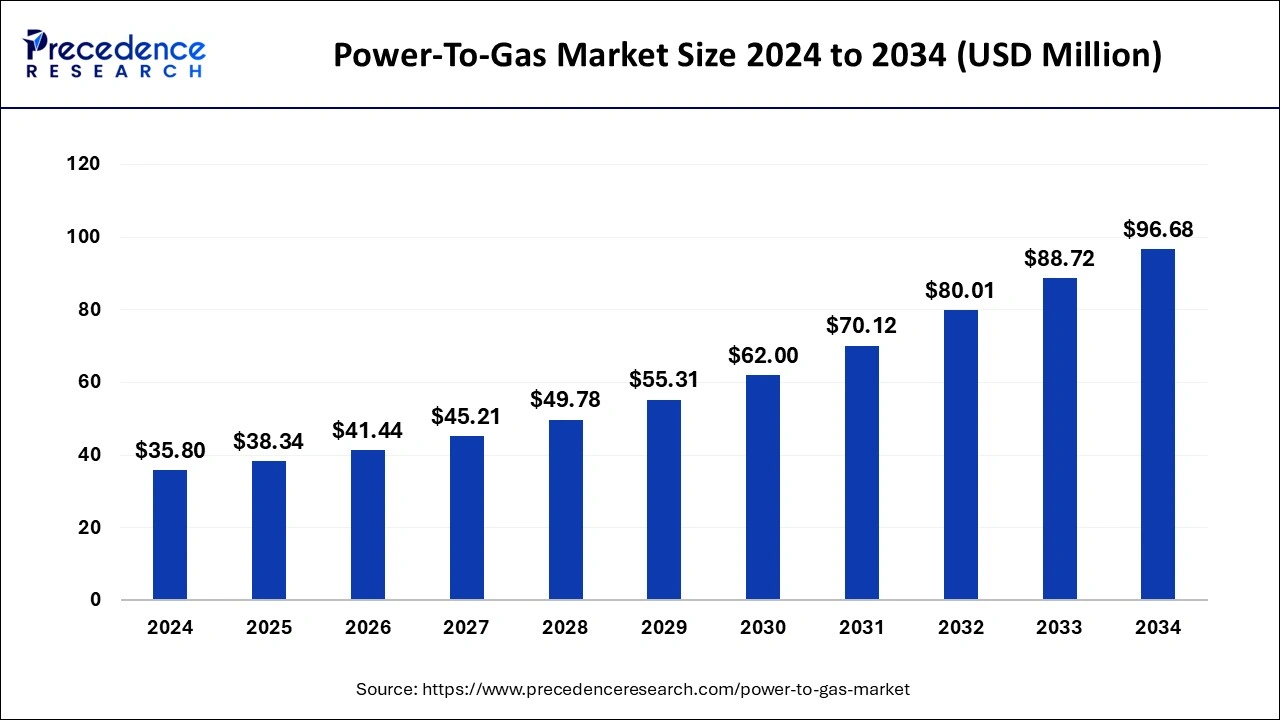
Power-To-Gas Market Key Takeaways
- Europe region held the highest revenue share of 36% in 2024.
- By technology, the electrolysis segment held the largest market share in 2024.
- By technology, the methanation segment is anticipated to expand at the highest CAGR in the coming years.
- By end-user, the utilities segment captured the largest share of the market in 2024.
- By end-user, the commercial segment is expected to expand at a rapid pace over the projected period.
- By capacity, the less than 100 kW segment dominated the market with the largest share in 2024.
impact of AI on the Power-To-Gas Market
Artificial intelligence (AI) positively impacts the power-to-gas market. AI algorithms help in optimizing the operations of power-to-gas systems. These algorithms analyze data and monitor the system in real time. They also help control energy production and consumption, thereby increasing efficiency. Moreover, AI detects anomalies and predicts potential failures before they occur, which further reduces downtime.
Europe Power-To-Gas Market Size and Growth 2025 to 2034
The Europe power-to-gas market size reached USD 12.89 million in 2024 and is anticipated to be worth around USD 35.29 million by 2034, poised to grow at a CAGR of 10.60% from 2025 to 2034.
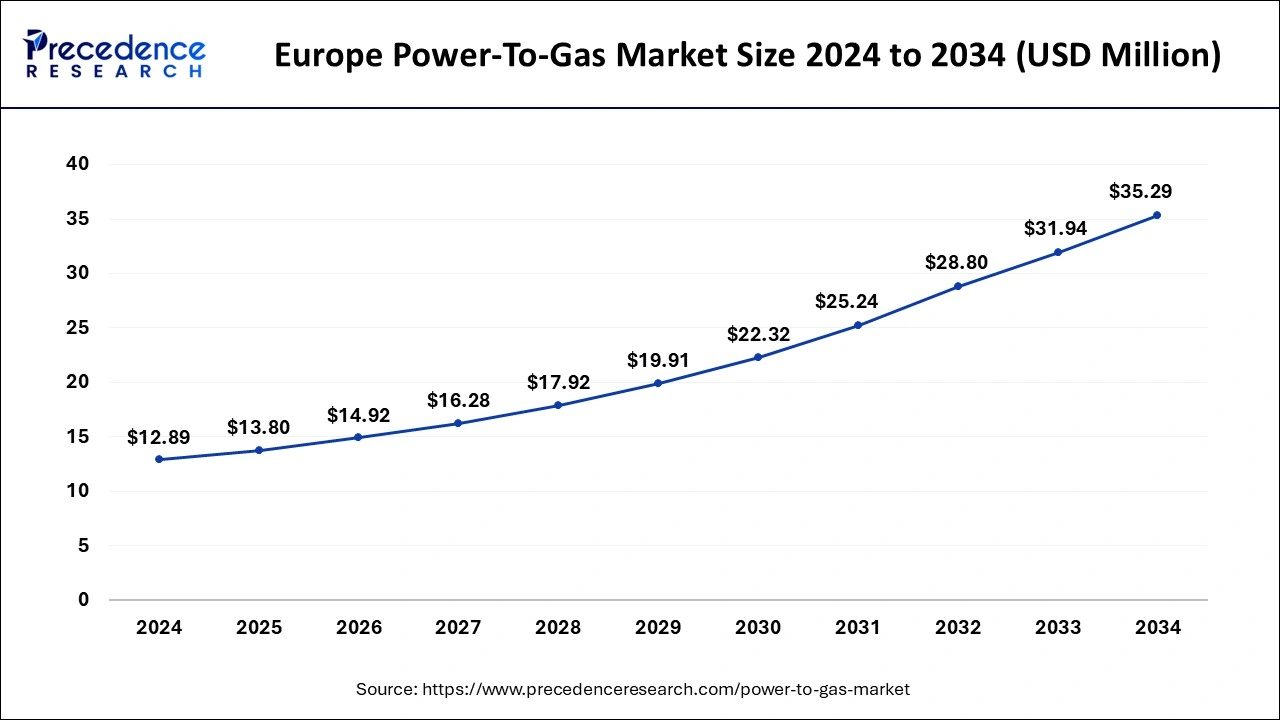
Europe region has held the highest revenue share of 36% in 2024. Some European nations, like Germany and Denmark, are in the midst of significant development of renewable electricity production, and it is anticipated that this will happen to a greater extent throughout Europe throughout the projected period. Low spot prices of electricity are anticipated to result from high power generation from intermittent sources. Additionally, it presents a chance for the creation of adaptable electro-intensive processes. Due to a number of programs and goals for integrating renewable electricity in Europe, power-to-gas has been technically validated at the pilot scale. In order to cut carbon emissions, the European energy sector is going through a significant transformation. The need for power-to-gas technology is anticipated to rise as a result of political RES integration and carbon reduction goals.
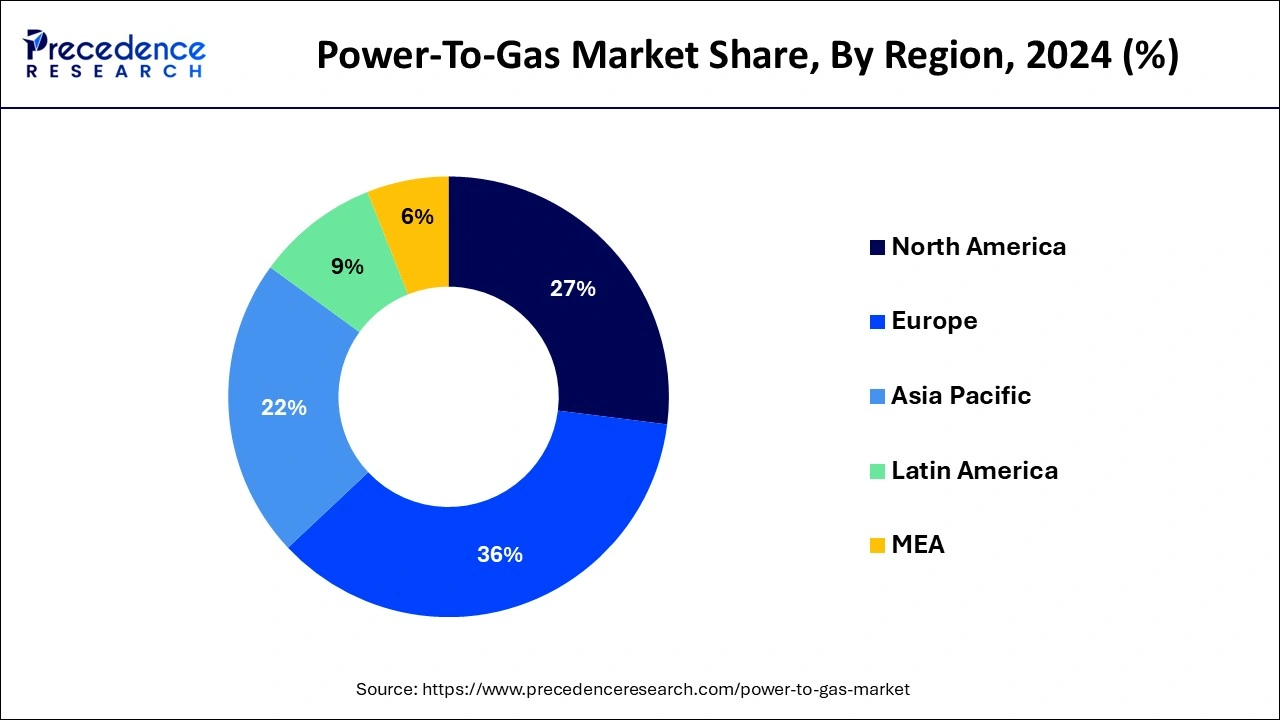
To create a sustainable future in the power-to-gas market, the region has implemented some of the highest environmental standards and aggressive climate policies in the world. The maintenance of environmental pollution, and climate change and reducing greenhouse gas emissions through effective renewable energy systems are top priorities.
The government policies of various countries are expected to cause the power-to-gas market in Asia Pacific to grow significantly. In addition, it is projected that the region's economic recovery from the COVID-19 epidemic will further fuel the rise of the power-to-gas business in the ensuing years.
What Are the Key Trends Driving Growth in the North America Power-to-Gas Market?
The power-to-gas market in North America continues to grow significantly as there is a significant concentration on integrating new renewable energy and identifying energy sustainability opportunities. The increased investments in green hydrogen production are justified by the favourable regulatory policies to achieve carbon reduction and support the usage of clean energy. The region has also experienced major developments in the electrolysis and methanation technologies, enhancing efficiency in conversion and cost effectiveness.
The U.S. is also promoting the power-to-gas infrastructure as governmental and privately-led incentives and research subsidies become widespread. Those technologies allow grid stabilization and the decarbonization of the different sectors, such as transportation, industry, or power generation.
What Factors Are Driving the Rapid Expansion of the Asia Pacific Power-to-Gas Market?
The Asia Pacific power-to-gas market is expanding rapidly. Power-to-gas is an opportunity to solve the problem of excess renewable electricity, converting it to hydrogen or methane, making it easier to add to the power grid, and making energy more reliable. China is leading in market expansion due to the worthy government policies on the use of renewable energy, as well as reducing air pollution and limiting greenhouse gas emissions in the region.
The strategic planning based on the development of a hydrogen economy concurs with the significant investments of the country into power-to-gas infrastructure and hydrogen production. Also, technology is becoming more efficient and scalable with the development of the electrolysis process and the methanation processes, both in the Asia Pacific region.
Market Overview
A technique known as "power-to-gas" converts electrical energy into methane or hydrogen syngas (synthetic gas). The hydrogen produced by the power-to-gas industry is used by other businesses as a chemical or fuel. Energy from renewable resources like wind and solar is stored in power-to-gas systems and used for a variety of uses. These systems utilize stored energy for transportation, heating, and industrial applications. The power-to-gas industry's operations are a positive step toward combining renewable resources with electricity-generating sources.
Growth in the demand for renewable hydrogen, which may lower carbon emissions in a range of different industries, is predicted to be the main factor driving the market's expansion. The primary element fueling the industry's expansion is the decline in the cost of electrolyzing technology. According to the International Energy Agency, electrolyze stacks represent between 50 and 60 percent of the capital investment. The remaining 40 to 50 percent of the investment is made up of components for the plant, power electronics, and gas conditioning. Global demand for power will increase due to population and economic expansion.
Power-To-Gas Market Growth Factors
- Renewable Energy Utilization: Power-to-gas technologies can convert excess renewable energy like wind or solar into gases like hydrogen or methane, which can be used during periods of low production or high demand.
- Integrated Power and Gas Networks: The connection of power and gas grids helps in the transfer of renewable energy in an efficient manner. This enables the conversion of excess electricity to gas, which is advantageous and helps to correct fluctuating energy systems.
- Growing Electricity Demand: The global electricity demand is rising, particularly in emerging countries. However, power-to-gas technologies are crucial to help maintain the supply of electricity by converting the excess electricity into storable and transportable gases such as hydrogen.
- Demand from the Transportation Sector: There is a high demand for clean fuel in the transportation sector. However, power-to-gas technologies generate hydrogen, decreasing the need for fossil energy resources.
- Government Support: Governments around the world are providing incentives and subsidies for the development of power-to-gas technologies.
Market Scope
| Report Coverage | Details |
| Market Size in 2025 | USD 38.34 million |
| Market Size by 2034 | USD 96.68 million |
| Growth Rate from 2025 to 2034 | CAGR of 10.44% |
| Largest Market | Europe |
| Base Year | 2024 |
| Forecast Period | 2025 to 2034 |
| Segments Covered | By Technology, By End User, and By Capacity |
| Regions Covered | North America, Europe, Asia-Pacific, Latin America, and Middle East & Africa |
Market Dynamics
Key Market Drivers
- Increasing demand for renewable hydrogen - The market is anticipated to rise as a result of the rising demand for renewable hydrogen, which has the ability to decarbonize numerous industries. The market is expanding as a result of the electrolyze technology's declining cost. According to the International Energy Agency, the electrolyze stacks account for between 50% and 60% of the capital expenditure, with the remaining costs being covered by things like power electronics, gas-conditioning, and plant components. By 2021, it is anticipated that high-temperature electrolysis prices will have decreased by 80%. Important players are also concentrating on developing modular renewable methane production. For instance, APA Group received a US $1.1 million grant from the Australian Renewable Energy Agency to construct a renewable methane production demonstration facility.
- Increasing demand for electricity - The demographic and economic expansion of nations around the world is predicted to lead to an increase in the demand for electricity on a global scale. Companies are looking for ways to generate energy that is more affordable and efficient. Additionally, they are looking for ways to generate electricity that doesn't harm the environment. With the help of power-to-gas technology, renewable energy sources like solar and wind can be successfully integrated and stored for a long time. Since there are no toxic gases released, the electricity-to-gas technique has no negative effects on the environment.
- Growing environmental concerns - The industry is expected to grow during the forecast period as a result of escalating environmental concerns. The government's increased efforts to lower the number of greenhouse gases produced by conventional vehicles are a factor in the system's rising demand. It is anticipated that the recent drop in the cost of renewable energy generation from sources like wind and solar will increase demand for power to the gas system. The governments of North America, Europe, and Asian nations are offering a variety of subsidies and incentives, such as tax breaks and unique advantages when registering new cars, to stimulate the sales of electric vehicles. To reduce CO2 emissions and improve air quality, the public sector is spending extensively on electrifying public transportation and increasing the manufacturing of electric buses. Therefore, the government's upcoming measures will undoubtedly benefit power to gas systems. In addition, the power utilities are working with producers of electric vehicles, which is another element contributing to the expansion of the power to the gas industry.
Key Market Challenges
- Price fluctuations for natural gas - The crude oil price cycle is a trend that the swings in natural gas prices have obliquely followed. LNG import costs considerably increased following the global financial collapse in 2009. But a few years later, prices fell sharply because of failing worldwide economic conditions. With the quick switch to the preference and adoption of gas as a fuel, the dependency on natural gas is growing. The likelihood of using natural gas as a fuel is anticipated to increase during the projected period due to the low natural gas costs at the moment. However, over time, this reliance on natural gas will cause its prices to rise due to the increasing demand, which would limit the market's ability to grow.
Key Market Opportunities
- Rising green hydrogen infrastructure - It is anticipated that rising initiatives to build green hydrogen infrastructure in developing economies will soon open up significant potential for businesses in the power to the gas sector.
Technology Insights
The electrolysis segment dominated the market with the largest share of 70% in 2024. This is mainly due to its enhanced efficiency in converting excess renewable energy into hydrogen. Due to the increased awareness about the negative impact of greenhouse gases, there is a high demand for green fuel, bolstering the segmental growth.
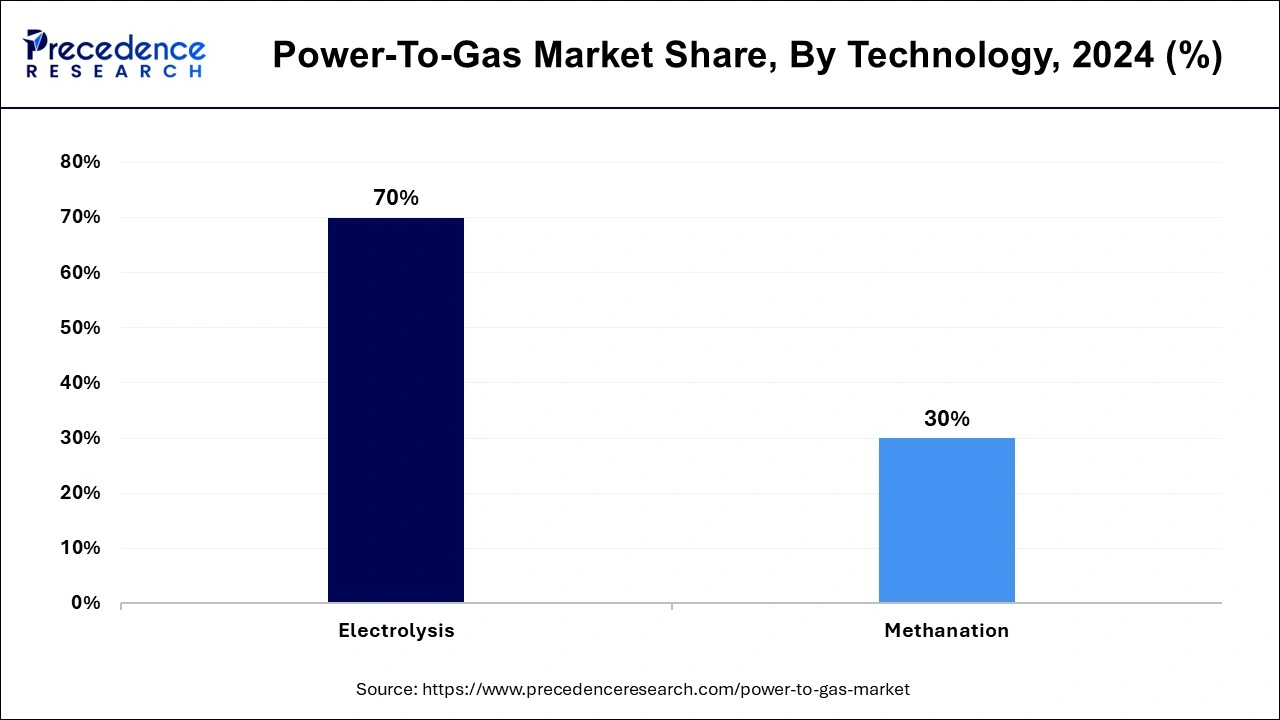
Because of the increased usage of renewable energy sources and the need to reduce carbon emissions, the segment is growing. Additionally, one of the elements propelling the segment's growth is the increasing need for fuel cells in electric vehicles. Since hydrogen produces fuel cells more efficiently and with fewer emissions, it is now used more frequently in manufacturing.
The Methanation segment is anticipated to witness rapid growth over the projected period. Methanation technology refers to the process whereby hydrogen and carbon dioxide are converted into methane. It builds on the existing physical infrastructure for natural gas and offers renewable energy storage. The compatibility with water and the possibility of using CO2 make methanation an important complementary process within the P2G value chain.
End User Insights
The commercial segment is expected to expand at a rapid pace over the projected period. Power-to-gas technologies are used in businesses to convert excess renewable energy into hydrogen or methane, reduce carbon emissions, and adhere to rules and policies. The chemical process, refinery, and steel manufacturing industries are known to harness a considerable amount of hydrogen. These industries are currently making significant efforts to reduce carbon generation and shift to cleaner manufacturing techniques. However, P2G technologies present the most suitable option for on-site hydrogen generation. There is also a growing demand for localized storage solutions due to concerns over energy security and uncertainty of prices.
Capacity Insights
The less than 100 kW segment accounted for the largest market share in 2024. The drivers for the power-to-gas market of less than 100 kW through methanation comprise decentralized and integrated renewable energy systems. These small capacities enable efficient conversion of carbon dioxide and hydrogen into synthetic methane, making them attractive for local energy applications.
Power-To-Gas Market Companies
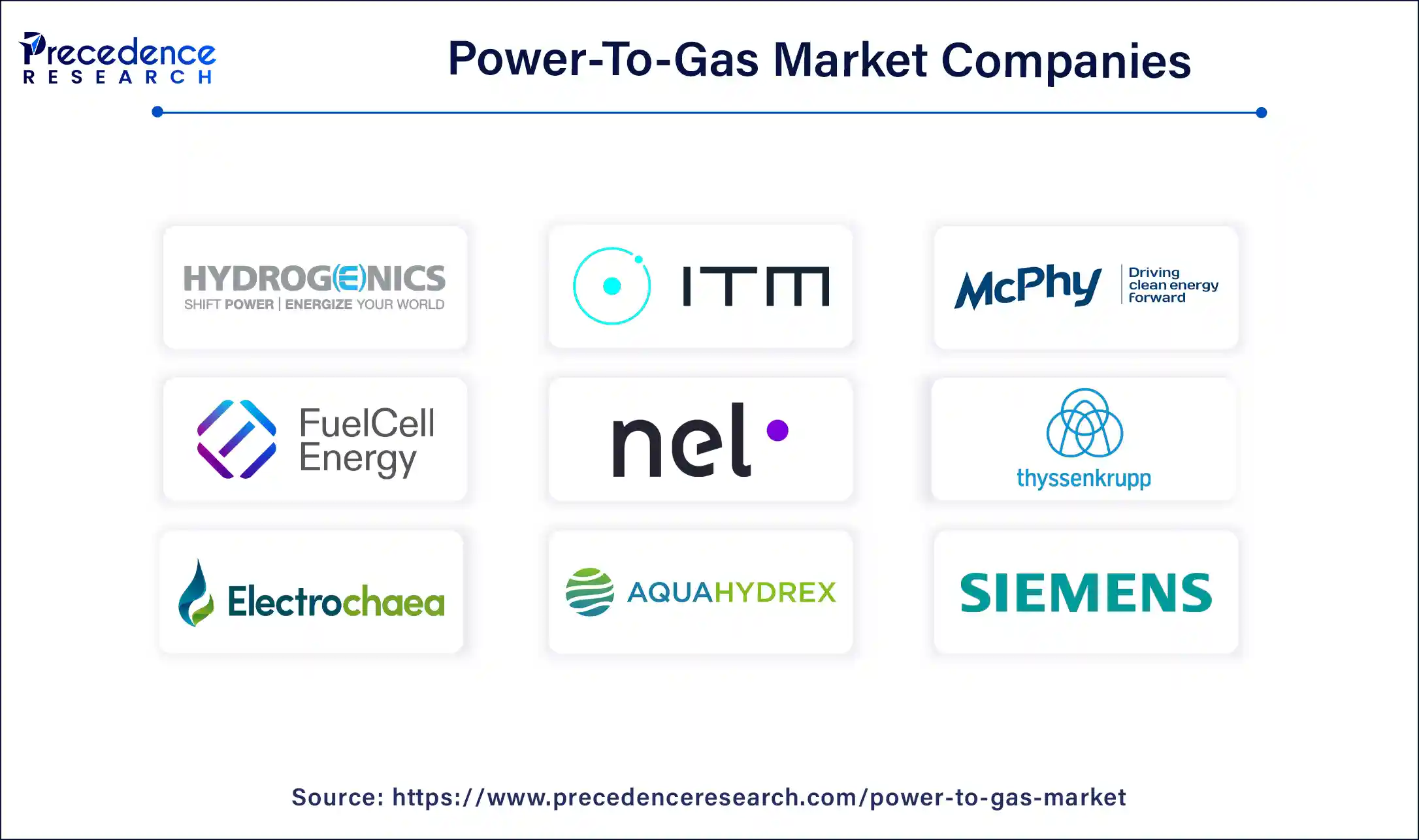
- Hydrogenics
- ITM Power
- McPhy Energy
- Fuelcell Energy
- Nel Hydrogen
- ThyssenKrupp
- Electrochaea
- Carbotech
- Power-to-gas Hungary
- Aquahydrex
- Ineratec
- Exytron
- GreenHydrogen
- Hitachi Zosen Inova Etogas
- Siemens
- MAN Energy Solutions
- Uniper
- Micropyros
- Socalgas
Recent Development
- In June 2024, Siemens Energy will contract for $1.5 billion for the long-term maintenance of two gas-fired power plants in Saudi Arabia. The contract is 25 years in length and allows Siemens to supply technology for the power plants, which together generate approximately 4GW for the country.
(Source: https://www.power-technology.com) - In May 2024, Nel Hydrogen Electrolyzer AS, a wholly owned subsidiary of Nel ASA, signed a technology license agreement with Reliance Industries Limited (RIL) in a transaction granting RIL exclusive rights in India to use Nel's alkaline electrolytes. RIL was also authorized to manufacture Nel's alkaline electrolyzers for use in India and to manufacture portable and stationary domestic use alkaline electrolyzers worldwide.
(Source: https://nelhydrogen.com) - In March 2024, ITM Power announced its partnership with Sumitomo Corporation for the delivery and installation of the NEPTUNE electrolyzer at the Yokohama Techno Station of Tokyo Gas Co, Ltd. This is the first MW-class PEM power plant manufactured outside of Japan and exported for use in Japan.
(Source: https://itm-power.com) - In November 2023, Nature Energy and Andel inaugurated a new power-to-gas facility in Denmark. The companies have invested in a biological Power-to-X plant located in Glansager. Once fully operational, the plant will produce hydrogen that will enhance Nature Energy's green gas output by 12,000 m³ per day.
Segments Covered in the Report
By Technology
- Electrolysis
- Methanation
By End User
- Commercial
- Utilities
- Industrial
By Capacity
- Less than 100 kW
- 100–999 kW
- 1000 kW and Above
By Geography
- North America
- Europe
- Asia-Pacific
- Latin America
- Middle East & Africa (MEA)
For inquiries regarding discounts, bulk purchases, or customization requests, please contact us at sales@precedenceresearch.com
Frequently Asked Questions
Ask For Sample
No cookie-cutter, only authentic analysis – take the 1st step to become a Precedence Research client